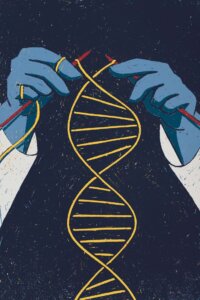
Schizophrenia is a serious mental illness that affects behaviors, thought patterns, and emotional state (U.S. Department of Health and Human Services, 2023). Although it is not one of the most common mental illnesses, it does affect approximately 24 million people worldwide (World Health Organization, 2022). The stigma that surrounds Schizophrenia is widespread and severe due to misinformation in the media. Those diagnosed with Schizophrena’s relationships are negatively impacted by stigmas and they are often socially excluded (World Health Organization, 2022). This plays a factor in decreased access to healthcare, housing, proper education, and employment which in turn lowers the individual’s quality of life and chances of effectively treating the diagnosis.
Media Myths 
The misinformation spread throughout the media can scare those who are at-risk or already have the diagnosis along with their family members. There is fear, stigma, and propaganda due to producers and authors not researching in depth the truth of the diagnosis and its symptoms before releasing this information to the public.
Movie Myth Number 1
The movie Me, Myself, and Irene (2000) misrepresents schizophrenia viewing the diagnosis as a split personality disorder. In the trailer it states “…diagnosed you with having split personality, a schizo.” It displays an inaccurate view and stigma around schizophrenia, making those who are diagnosed with schizophrenia seem dangerous and violent. This movie depicts two characters, Charlie and Hank. Charlie is viewed as a kind and non-confrontational father, while Hank is viewed as an aggressive confrontational maniac. He is seen in the trailer driving into buildings, tricking someone into having intercourse, and fighting with his opposite personality. The end of the movie portrays that Charlie’s Schizophrenia is cured by his self-control and because of a woman he fell in love with, not actual treatment.
Facts
The website titled Schizophrenia posted by the U.S. Department of Health and Human Services is a credible and current source of information for the diagnosis and treatment of Schizophrenia. Schizophrenia is not a split personality disorder or Dissociate Identity Disorder. Although some symptoms may be similar, the difference is that a split personality disorder involves two or more present distinct personalities that every so often take control over the person (U.S. Department of Health and Human Services, 2023). Most people with Schizophrenia are also not usually violent and are more likely to be harmed by others. If left untreated, the risk can be greater for self-harm or violence towards others (U.S. Department of Health and Human Services, 2023).

By: Jamie
Having a good support system is important for treatment, but it does not cure the illness alone. Effective treatment options include:
- Antipsychotic medication
- Psychosocial treatments such as cognitive behavioral therapy and behavioral skills training
- Coordinated specialty care (CSC) programs is a program focused on recovery for early stages of Schizophrenia
- Education and support
- Assertive community treatment (ACT) is aimed for patients in the community at-risk for homelessness or several hospitalizations
- Facilitated assisted living
- Supported housing
- Supported employment
Proper Media Portrayal
The movie A Beautiful Mind published by Universal Pictures, accurately portrays the symptoms of Schizophrenia, unlike the movie Me, Myself, and Irene (2000) which depicts Schizophrenia as a multiple personality disorder. It is based on a real-life story of a man named John Nash diagnosed with paranoid Schizophrenia. Nash experiences auditory and visual hallucinations, as well as delusions of being drafted by the government to be a code breaker which he becomes obsessed with (Howard, 2001). Nash is also seen throughout the movie lacking social and emotional awareness, he struggles with dealing with and expressing these emotions (Howard, 2001). Due to this struggle of real-life perceptions, it makes it difficult for Nash to express concern in an appropriate way. His wife seeks help for Nash through medication and therapy treatment. In the end Nash faces these delusions and realizes that they are not real life. This movie properly portrayed the onset of symptoms, grandiose delusions, lack of emotion, treatment, and how schizophrenia can impact someone’s life (Howard, 2001). It shows that this diagnosis can be overcome and provides hope to viewers. The one part of the movie depicted wrong was that Nash did not experience visual hallucinations, but nonetheless they were accurately portrayed.
Movie Myth Number 2
The movie The Visit (2015) portrayed a stigmatized view of schizophrenia. This movie is about two teenagers whose mother had a falling out with their grandparents, so they both had never met them. Their grandparents were acknowledged to have jobs at a psychiatric hospital. When they arrive at the house, they notice their grandparents are acting strangely. The grandchildren find out that the grandparents they are visiting are not their real grandparents, but instead two people who escaped from the psychiatric hospital, killed their real grandparents, and consumed their identities.
The grandmother is seen:
- Crawling around the house
- Growling
- Trying to strangle herself while having a hallucination
- Tries to persuade the granddaughter to get into the oven
- Attacks grandchildren in psychotic episode
- Attempts killing both the grandchildren in their sleep
- Naked and scratching at a door
- Laughing in a rocking chair staring at the wall stating she laughs to keep the bad spirits inside of her at bay
It was also found that the fake grandmother killed her own children in a delusional state by drowning them in a pond to grant them eternal life to the aliens prior to her admission.
The grandfather is seen:
- Attacking a man on the street
- Attempting suicide with his shot gun
- Helping the grandmother hang a woman from a tree
- Trying to kill the granddaughter
- Tortures the grandson by smudging a dirty diaper across the grandson’s face.
The fake grandfather was isolated from everyone after admitting to his delusions prior to his admission. He was fired from his job due to seeing white apparitions with yellow eyes following him
Facts
This movie not only creates fear around or for those diagnosed with schizophrenia but misrepresents the illness and most of its symptoms. The three categories of Schizophrenia include:
Psychotic symptoms may come and go or eventually become stable. These symptoms include:
- Hallucinations: Seeing, hearing, tasting, smelling, or feeling things that are not there.
- Delusions: Strong incorrect beliefs that seem irrational to others.
- Thought disorder: Disorganized thoughts and speech.
- Movement disorder: Repeating and abnormal body movements.
Negative can be confused for depression or symptoms of another mental illness. These symptoms include:
- Planning and carrying out activities
- Difficulty enjoying daily activities
- Either avoiding socialization or expressing awkardness
- Lack of energy and participating in mostly passive activities
Cognitive involve difficulties with concentration, attention, and memory. These symptoms include:
- Difficulty making decisions due to trouble processing information
- Difficulty acting on newly learned information
- Decreased attention span
Proper Media Portrayal
In the book The Heartland: Finding and Losing Schizophrenia published by Faber & Faber, the author debunks myths and combats stigma around Schizophrenia. Filer discusses real life stories through patient, family, and healthcare provider interviews. Additionally, Filer provides information on misinformation and the impact this has on emotionally, socially, and physically for those affected (Filer, 2019). He also discusses the science and politics regarding diagnosis and treatment. Filer was a former psychiatric nurse and recalls the first time medicating a patient against their will while they were restrained by four other nurses. He states that he immediately acknowledged his contribution to that patients suffering and that from his own experiences with mental health care he can recognize the ethical, clinical, and political complications surrounding it. Filer also mentions many real life case scenarios of patients and their families in this book.
“… it might be best understood as a kind of psychological adaptation, a coping strategy gone awry or a form of storytelling carried out within the mind as a response to unbearably painful life events” (Filer, 2019).
This is a quote aimed at those who view Schizophrenia as scary or dangerous, to offer a new perspective on the reasoning behind these symptoms.
Movie Myth Number 3
The movie Fisher King (1991) is about a man named Jack who is a talk show host that caused a radio fan to commit murder. Finding out this news he decides to give up on his life until he runs into a homeless man named Parry who states that he is a knight on a sacred quest. Jack decides to help Parry try to get a girl he loves to redeem himself for his past actions. In the trailer itself people state that Parry is “out of his mind” and presents Parry as a seemingly psychotic and uncleanly man who trash picks, displays inappropriate behavior, and makes provocative comments. This trailer ends by the narrator stating, “To find yourself you have to risk it all”, insinuating that Jack risked helping Parry to find himself and that Jack helped cure Parry’s Schizophrenia. Initially, Parry developed Schizophrenia and Post-Traumatic Stress Disorder (PTSD) after seeing his wife get murdered in a restaurant massacre. This movie leaves out if the disorder is genetic or if he was at risk previously to this incident. This can misinform the public about the correct symptom’s schizophrenia would entail, allow people to believe that having PTSD means also developing schizophrenia, or that schizophrenia can be triggered by a traumatic event which is false.
Facts
Schizophrenia is not caused by a singular traumatic event with no other risk factors. The risk factors that contribute to Schizophrenia include:
- Genetics
- Environmental Factors which involves a combination of genetic, environment and life events.
- Psychosocial factors involving brain structure and functions
Proper Media Portrayal
Those diagnosed with Schizophrenia are also able to maintain jobs and live fulfilling lives. The book The Center Cannot Hold: My Journey Through Madness published by Hachette Go is a memoir about the author Saks life from before and after her diagnosis of Schizophrenia. While struggling with Schizophrenia symptoms and finding proper treatment, she discovers a therapist named Dr. White while attending Yale who effectively treats her with psychoanalysis and medication (Saks, 2020). She goes on to graduate from Yale and becomes an admired professor at University of Southern California, gets married, publishes academic books and articles, attains her tenure, and practices psychoanalysis. This book shows the struggles of those diagnosed with Schizophrenia, proper and improper treatment, and that those diagnosed can still lead a fulfilling and happy life (Saks, 2020)
References
- Saks, E. R. (2020). The center cannot hold: My journey through madness. Hachette Go, an imprint of Hachette Books.
- World Health Organization. (2022, January 10). Schizophrenia. World Health Organization. Retrieved April 30, 2023, from https://www.who.int/news-room/fact-sheets/detail/schizophrenia
- U.S. Department of Health and Human Services. (2023, May). Schizophrenia. National Institute of Mental Health. Retrieved April 30, 2023, from https://www.nimh.nih.gov/health/topics/schizophrenia
- Howard, R. (2001). A Beautiful Mind. Universal Pictures.
- Filer, N. (2019). The Heartland: Finding and Losing Schizophrenia. Faber & Faber.

Excellent blog. The media loves to demonize any mental illness especially the rare ones. The examples you used were perfect with great followup with research!
Great job
Denise
I really enjoyed your blog! It was so informative and educational. I also did my blog about a mental illness disorder and thought you did a great job explaining schizophrenia in a way that the public can understand. You chose some great media clips that truly show the myths that the media puts out there about schizophrenia. Amazing job!
I am so happy you picked this! I was looking into this topic myself and felt a little overwhelmed. You did an excellent job breaking down myths and chose purposeful media clips! The fear and stigma surrounding different diagnosis is such a hinderance in individuals wellbeing. You touched on many important facts. Thank you!
I looked forward to reading your blog as I am very interested in your topic. I absolutely agree that schizophrenia is extremely stagmatized. I thought you did a great job presenting the information. You made good use of headings/subheadings and bullet points which present the information in easy to read “chunks”. All visuals are relevant to your topic and not overwhelming. Great job!
I thoroughly enjoyed reading your blog about schizophrenia and its misinterpretation by the media. The stigma surrounding the condition can be so dangerous. I really enjoyed how you explained schizophrenia in an easy clear and concise way, you made it very easy to understand and stuck to the main points. I also liked your examples of how the condition is misinterpreted. This post raises great awareness about a mental health disorder that is often misunderstood. Kudos!